Concept for the Future Utilization of Lunar Underground Space and Adaptive Design Strategies
Abstract
1. Introduction
2. Development History of Research on Lunar Underground Space Utilization


3. Conceptual Vision for the Future Development of Lunar Underground Space Utilization
3.1. Principles to Guide Future Utilization of Lunar Underground Space
3.2. Conceptual Vision for the Future Development of Lunar Underground Space Utilization
4. Adaptive Design Strategies for Future Lunar Underground Space Utilization
4.1. Definition of Adaptive Design
4.2. Adaptive Design Strategies for Lunar Underground Space Utilization
4.2.1. Spatial Adaptability Design Strategies
4.2.2. Environmental Adaptability Design Strategies
4.2.3. Climate Adaptability Design Strategies
5. Conclusions
Author Contributions
Funding
Data Availability Statement
Conflicts of Interest
References
- Constellation Program Overview. Available online: https://epizodsspace.airbase.ru/bibl/inostr-yazyki/nasa/2006/Connolly_Constellation_Program_Overview_%28Oct-2006%29.pdf?utm_source (accessed on 1 January 2020).
- China Aerospace Editorial. Peminov Talks About Russian Space Program. China Aerosp. 2007, 9–10. [Google Scholar]
- Kohtaro, M. Moon and planetary exploration in JAXA. In Proceedings of the 2nd Space Exploration Conference, Houston, TX, USA, 30 January–1 February 2006; Volume 12, pp. 1–10. Available online: https://www.scribd.com/document/350209/NASA-164272main-2nd-exp-conf-12-InternationalExplorationPerspective-KMatsumoto (accessed on 1 January 2020).
- Kohtaro, M. Robotic Lunar Exploration Scenario. JAXA Plan 2006, 5, 1–26. Available online: https://it.scribd.com/document/207163704/1-JAXA (accessed on 8 November 2025).
- Yu, D.Y.; Ge, Z.J.; Wang, N.D.; Xiao, L.; Lin, Z.J. Supposal for structure form of lunar base. J. Astronaut. 2012, 33, 1840–1844. (In Chinese) [Google Scholar] [CrossRef]
- Guo, L.L.; Wang, P.; Zhu, S.Y. Engineering for Manned Lunar Base; China Astronautic Publishing House: Beijing, China, 2013; ISBN 9787515905921. (In Chinese) [Google Scholar]
- Crawford, I. Why we should build a Moon Village. Astron. Geophys. 2017, 58, 6–18. [Google Scholar] [CrossRef]
- Pei, Z.Y.; Liu, J.Z.; Wang, Q.; Kang, Y.; Zou, Y.; Zhang, H.; Zhang, Q.; He, H.; Wang, Q.; Yang, R.; et al. Overview of lunar exploration and international lunar research station. Chin. Sci. Bull. 2020, 65, 2577–2586. (In Chinese) [Google Scholar] [CrossRef]
- Liu, J.J. New World Space Technologies—Lunar Space Station. Satell. Netw. 2020, 56–63. (In Chinese) [Google Scholar]
- Inflatable Habitation for the Lunar Base. Available online: https://ntrs.nasa.gov/api/citations/19930008253/downloads/19930008253.pdf?utm_ (accessed on 1 January 2020).
- Nowak, P.S.; Sadeh, W.Z.; Morroni, L.A. Geometric Modeling of Inflatable Structures for Lunar Base. J. Aerosp. Eng. 1992, 5, 311–322. [Google Scholar] [CrossRef]
- Hauplik-Meusburger, S.; Ozdemir, K. Deployable lunar habitation design. In Moon: Prospective Energy and Material Resources, 1st ed.; Badescu, V., Ed.; Springer: Berlin, Germany, 2012; pp. 469–502. [Google Scholar]
- Zhou, C.; Chen, R.; Xu, J.; Ding, L.; Luo, H.; Fan, J.; Chen, E.J.; Cai, L.; Tang, B. In-situ construction method for lunar habitation: Chinese Super Mason. Autom. Constr. 2019, 104, 66–79. [Google Scholar] [CrossRef]
- Ye, P.J.; Yu, D.Y.; Sun, Z.Z.; Shen, Z.R. Achievements and prospects of Chinese lunar probes. J. Deep Space Explor. 2016, 3, 323–333. [Google Scholar] [CrossRef]
- China National Space Administration. International Lunar Research Station Partnership Guide [EB/OL]. Available online: https://www.cnsa.gov.cn/n6758823/n6758838/c6812147/content.html (accessed on 16 June 2021).
- Zhu, E.Y.; Guo, L.L.; Chen, C. Conceptual design scheme of manned lunar base. Aerosp. Return Remote Sens. 2013, 34, 1–6. (In Chinese) [Google Scholar] [CrossRef]
- Guo, L.L.; Li, Z.J.; Qi, B.; Liang, L.; Ye, P.J. Integrated overall scheme and construction plan conception for manned lunar base. Aerosp. Return Remote Sens. 2014, 35, 1–10. (In Chinese) [Google Scholar] [CrossRef]
- Mei, H.Y.; Bao, W.M.; Yu, D.Y.; Liu, P.Y.; Wang, Y.S.; Pan, W.T.; Chen, Y.; Li, J.Y.; Gao, Z.Y.; Fei, T. Research on building plans design for future lunar base. J. Deep Space Explor. 2022, 9, 553–559. (In Chinese) [Google Scholar] [CrossRef]
- Liu, Y.Q.; Mei, H.Y.; Liu, P.Y.; Pan, W.T. The design strategy of habitat in lunar environment. Contemp. Archit. 2022, 21–24. (In Chinese) [Google Scholar]
- Ding, L.Y.; Zhou, C.; Gao, Y.Y.; Han, W.B. Progress and scientific-technical challenges in extraterrestrial construction research. J. Civ. Eng. 2024, 57, 26–42. (In Chinese) [Google Scholar] [CrossRef]
- Zhou, C.; Gao, Y.Y.; Qin, W.B.; Ding, L.Y. Development trend, objectives, and policy path of lunar base construction. Chin. Sci. Bull. 2025, 70, 3460–3469. (In Chinese) [Google Scholar] [CrossRef]
- Shi, X.B.; Li, Y.Z.; Huang, Y.; Wang, J. Conceptual design of lunar surface environment simulation system. Eng. Sci. 2006, 8, 48–52. (In Chinese) [Google Scholar]
- Feng, X.; Guo, Q. Lunar surface temperature real-time model. J. Remote Sens. 2017, 21, 928–938. (In Chinese) [Google Scholar] [CrossRef]
- Zhou, C.; Li, X.; Gao, Y.; Chen, R. Parametric design and optimization for lava tubes-like lunar arch habitation with large span. Space Habitat. 2025, 1, 100001. [Google Scholar] [CrossRef]
- Ma, Y.; Mei, H.; Xu, X.; Pan, W.; Wang, L. Computational morphogenesis method for the lunar shelter based on the principle of inverse hanging simulation and bi-directional evolutionary structural optimization. Acta Astronaut. 2026, 238, 377–390. [Google Scholar] [CrossRef]
- Kaplicky, J.; Nixon, D. A Surface-Assembled Superstructure Envelope System to Support Regolith Mass-Shielding for an Initial-operational-Capability Lunar Base. In Lunar Bases & Space Activities of Century; Lunar and Planetary Institute: Houston, TX, USA, 1985; p. 375. Available online: https://www.adsabs.harvard.edu/full/1985lbsa.conf.375K (accessed on 8 November 2025).
- Burry, J.; Latifi, M. Arcological City: Going Underground. Archit. Des. 2023, 93, 54–61. [Google Scholar] [CrossRef]
- Rezaee, R.; Vakilinezhad, R.; Shahzadeh, M. The “Shavadun” as an Ecological Solution for Architecture in a Hot Climate. WIT Trans. Ecol. Environ. 2009, 120, 303–313. [Google Scholar] [CrossRef]
- Xu, X.H.; Liang, X.G.; Ren, J.X. Numerical analysis of thermal environment of lunar surface. J. Astronaut. 2006, 27, 153–156. (In Chinese) [Google Scholar]
- Wagner, R.V.; Robinson, M.S. Distribution, formation mechanisms, and significance of lunar pits. Icarus 2014, 237, 52–60. [Google Scholar] [CrossRef]
- Lee, P. Possible lava tube skylights near the north pole of the moon. In Proceedings of Lunar and Planetary Science Conference, The Woodlands, TX, USA, 10–14 March 2025; Lunar and Planetary Institute: Houston, TX, USA, 2018; p. 2083. Available online: https://ui.adsabs.harvard.edu/abs/2018LPI....49.2982L/abstract (accessed on 8 November 2025).
- Qiu, X.; Ding, C. Radar observation of the lava tubes on the moon and Mars. Remote Sens. 2023, 15, 2850. [Google Scholar] [CrossRef]
- Sauro, F.; Pozzobon, R.; Massironi, M.; De Berardinis, P.; Santagata, T.; De Waele, J. Lava tubes on Earth, Moon, and Mars: A review on their size and morphology revealed by comparative planetology. Earth-Sci. Rev. 2020, 209, 103288. [Google Scholar] [CrossRef]
- Xiao, L.; Huang, J.; Zhao, J.W.; Zhao, J.N. Significance and preliminary proposal for exploring the lunar lava tubes. Sci. China Phys. Mech. Astron. 2018, 48, 119602. (In Chinese) [Google Scholar] [CrossRef]
- Green, J. The geology of the lunar base. Ann. N. Y. Acad. Sci. 2010, 105, 491–625. [Google Scholar] [CrossRef]
- Halliday, W.R. Terrestrial pseudokarst and the lunar topography. Bull. Natl. Speleol. Soc. 1966, 28, 167–170. [Google Scholar]
- Oberbeck, V.R.; Quaide, W.L.; Greeley, R. On the origin of lunar sinuous rilles. Mod. Geol. 1969, 1, 75–80. [Google Scholar]
- Haruyama, J.; Sawai, S.; Mizuno, T.; Yoshimitsu, T.; Fukuda, S.; Nakatani, I. Exploration of lunar holes, possible skylights of underlying lava tubes, by smart lander for investigating moon (SLIM). Trans. Jpn. Soc. Aeronaut. Space Sci. 2012, 10, 7–8. [Google Scholar] [CrossRef]
- Ding, C.; Xu, J.; Zhi, Y.; Sharma, R.; Liang, Z.; Chen, W.; Qiu, X.; Jiang, C. Towards a habitable Moon: Probing subsurface cavities with global penetrating radar. npj Space Explor. 2025, 1, 11. [Google Scholar] [CrossRef]
- Marshall Porterfield, D.; Tulodziecki, D.; Wheeler, R.; Davis Cross, M.K.; Monje, O.; Rothschild, L.J.; Barker, R.J.; Schwertz, H.; Collicott, S.; Dutta, S. Critical investments in bioregenerative life support systems for bioastronautics and sustainable lunar exploration. npj Microgravity 2025, 11, 57. [Google Scholar] [CrossRef]
- Verseux, C.; Poulet, L.; de Vera, J.-P. Editorial: Bioregenerative life-support systems for crewed missions to the Moon and Mars. Front. Astron. Space Sci. 2022, 9, 977364. [Google Scholar] [CrossRef]
- Lasseur, C. MELiSSA: The European project of a closed life support system. In Proceedings of the 37th COSPAR Scientific Assembly, Montreal, QC, Canada, 13–20 July 2008; Volume 37, p. 1706. Available online: https://ui.adsabs.harvard.edu/abs/2008cosp...37.1706L (accessed on 1 January 2020).
- Wang, Y.; Jing, X.; Lv, K.; Wu, B.; Bai, Y.; Luo, Y.; Chen, S.; Li, Y. During the long way to Mars: Effects of 520 days of confinement (Mars500) on the assessment of affective stimuli and stage alteration in mood and plasma hormone levels. PLoS ONE 2014, 9, e87087. [Google Scholar] [CrossRef]
- Shiro, B.R.; Rowland, S.K.; Hurtado, J.M.; Caldwell, B.J.; Bleacher, J.E.; Fagents, S.A.; Roma, P.G.; Bedwell-Torres, W.L.; Binsted, K. Geological tasks during HI-SEAS planetary analog mission simulations, Mauna Loa, Hawai’i. Planet. Space Sci. 2022, 212, 105409. [Google Scholar] [CrossRef]
- Baidu Baike: Moscow Metro Line 1. Available online: https://baike.baidu.com/item/%E8%8E%AB%E6%96%AF%E7%A7%91%E5%9C%B0%E9%93%811%E5%8F%B7%E7%BA%BF/9503484 (accessed on 4 October 2025).
- Wikipedia: Stockholm Metro. Available online: https://zh.wikipedia.org/wiki/%E6%96%AF%E5%BE%B7%E5%93%A5%E5%B0%94%E6%91%A9%E5%9C%B0%E9%93%81 (accessed on 4 October 2025).
- Zacharias, J.; Xu, M. Underground Systems and the Economic Development of Downtown Montreal. Int. Urban Plan. 2007, 28, 28–34. [Google Scholar]
- Wikipedia: Saint Petersburg Metro. Available online: https://zh.wikipedia.org/wiki/%E5%9C%A3%E5%BD%BC%E5%BE%97%E5%A0%A1%E5%9C%B0%E9%93%81 (accessed on 4 October 2025).
- Gizmodo. Helsinki’s Underground Shadow City. Available online: https://gizmodo.com/helsinkis-underground-shadow-city-5769445 (accessed on 4 October 2025).
- MTRY Helsinki Official Website. Available online: https://mtry.fi/en/helsinki/ (accessed on 4 October 2025).
- Besner, J. Cities Think Underground—Underground Space (Also) for People. Procedia Eng. 2017, 209, 49–55. [Google Scholar] [CrossRef]
- Canadian Society for Civil Engineering (CSCE). Montreal Metro. Available online: https://legacy.csce.ca/en/historic-site/montreal-metro/ (accessed on 4 October 2025).
- Zhou, X.; Li, S.; Wang, F. Exploring Sustainable Development and Utilization of Urban Underground Space: A Case Study of Toronto Underground Pedestrian System. Int. Urban Plan. 2017, 32, 116–124. [Google Scholar] [CrossRef]
- Bautrip Travel Guide: Toronto PATH. Available online: https://www.bautrip.com/travel-guide/toronto/path-toronto (accessed on 4 October 2025).
- Sapporo Chikagai Official Website: Company History. Available online: https://www.sapporo-chikagai.jp/company/about/history.php.html (accessed on 4 October 2025).
- Tan, F. The Light Rail System of Edmonton, Canada. Urban Rail Transit Res. 2008, 9, 91. [Google Scholar]
- Wikipedia: Churchill Station (Edmonton). Available online: https://en.wikipedia.org/wiki/Churchill_station_(Edmonton) (accessed on 4 October 2025).
- Ma, J. Legal, Administrative and Planning Issues in the Underground Development of Helsinki. Undergr. Space 1995, 142, 142–148. [Google Scholar]
- Wikipedia: Helsinki Metro. Available online: https://zh.wikipedia.org/zh-cn/%E8%B5%AB%E7%88%BE%E8%BE%9B%E5%9F%BA%E5%9C%B0%E9%90%B5 (accessed on 4 October 2025).
- Zhao, Y. Analysis of Underground Commercial Space Design in Cold-Region Cities: A Case Study of Hongbo Plaza, Harbin. Sichuan Archit. 2011, 31, 67–69. [Google Scholar]
- Wikipedia: Edmonton Pedway. Available online: https://en.wikipedia.org/wiki/Edmonton_Pedway (accessed on 4 October 2025).
- Aqua Magazine. Inside Helsinki’s Underground Swimming Pool. Available online: https://www.aquamagazine.com/builder/pools/article/15121938/inside-helsinkis-underground-swimming-pool (accessed on 4 October 2025).
- Sakakura, Y.; Shimizu, H.; Itabashi, H. Sapporo’s Urban Management and Roles of the Underground Path. In Proceedings of the 11th ACUUS Conference: “Underground Space: Expanding the Frontiers”, Athens, Greece, 10–13 September 2007; Available online: http://www.minetech.metal.ntua.gr/extras/acuus2007/papers/section_09/ACUUS_049a.pdf (accessed on 1 January 2020).
- Wikipedia: APIA Main Access to JR Sapporo Station. Available online: https://zh.wikipedia.org/wiki/File:APIA_Main_access_to_JR_Sapporo_station_2014.jpg (accessed on 4 October 2025).
- Wikipedia: JR Tower Building. Available online: https://zh.wikipedia.org/wiki/JR%E5%A1%94%E5%A4%A7%E6%A8%93 (accessed on 4 October 2025).
- TechTarget Data Center China. Available online: https://searchdatacenter.techtarget.com.cn/9-16510/ (accessed on 4 October 2025).
- Data Centre Magazine. Pionen: Inside the World’s Most Secure Data Centre. Available online: https://datacentremagazine.com/data-centres/pionen-inside-worlds-most-secure-data-centre (accessed on 4 October 2025).
- Baidu Baike: Shenyang Metro. Available online: https://baike.baidu.com/item/%E6%B2%88%E9%98%B3%E5%9C%B0%E9%93%81/8312802#reference-30 (accessed on 4 October 2025).
- Vahaaho, I. An Introduction to the Development for Urban Underground Space in Helsinki. Tunn. Undergr. Space Technol. 2016, 55, 324–328. [Google Scholar] [CrossRef]
- Sapporo Travel: Chikaho Underground Path. Available online: https://www.sapporo.travel/zh/spot/facility/chikaho/ (accessed on 4 October 2025).
- China Designer News. Available online: http://news.china-designer.com/Get/hangyejd/140244469.htm (accessed on 4 October 2025).
- Tencent News. Available online: https://news.qq.com/rain/a/20250326A020DE00 (accessed on 4 October 2025).
- Baidu Baijiahao. Available online: https://baijiahao.baidu.com/s?id=1816789710141896740 (accessed on 4 October 2025).
- Railway Technology. Helsinki–Tallinn Railway Tunnel, Gulf of Finland. Available online: https://www.railway-technology.com/projects/helsinki-tallinn-railway-tunnel-gulf-of-finland/ (accessed on 4 October 2025).
- Johnson, R.W.; Penzo, P.A. The Extended Stay Lunar Exploration Mission. 1966. Available online: https://ntrs.nasa.gov/citations/19670042380 (accessed on 1 January 2020).
- Burke, J.D. Merits of a Lunar Polar Base Location. Lunar Bases and Space Activities of the 21st Century. 1985, p. 77. Available online: https://ui.adsabs.harvard.edu/abs/1985lbsa.conf...77B/abstract (accessed on 1 January 2020).
- Moore, G.T.; Baschiera, D.J.; Fieber, J.P.; Hansmann, T.; Huebner-Moths, J. Genesis Lunar Outpost: Criteria and Design; Center for Architecture and Urban Planning Research, University of Wisconsin-Milwaukee: Milwaukee, WI, USA, 1990; Available online: http://digital.library.wisc.edu/1793/89969 (accessed on 1 January 2020).
- Angelis, D.G.; Wilson, J.W.; Clowdsley, M.S.; Nealy, J.E.; Humes, D.H.; Clem, J.M. Lunar lava tube radiation safety analysis. J. Radiat. Res. 2002, 43, S41–S45. [Google Scholar] [CrossRef]
- Song, J.H.; Zhang, Y.S.H.; Yuan, H.X. A tentative plan of lunar base under lava tubes. Urban. Archit. 2019, 16, 44–51. (In Chinese) [Google Scholar] [CrossRef]
- Xie, H.P.; Zhang, G.Q.; Li, C.B. Scheme of underground space utilization of lunar thermostatic layer. Adv. Eng. Sci. 2020, 52, 1–8. (In Chinese) [Google Scholar] [CrossRef]
- Ding, J.; Xie, G.; Guo, L.; Xiong, X.; Han, Y.; Wang, X. Karst cave as terrestrial simulation platform to test and design human base in lunar lava tube. Space Sci. Technol. 2022, 2022, 9875780. [Google Scholar] [CrossRef]
- Xie, G.X.; Han, Y.; Yan, M.; Xiong, X.; Ding, J.H.; Wu, L.P. A tentative conception of building lunar farm with lava tube. J. Deep Space Explor. 2023, 10, 512–524. [Google Scholar] [CrossRef]
- Young Architects Competitions (YAC). Moon Station Competition. Young Architects Competitions. 2023. Available online: https://www.youngarchitectscompetitions.com/past-competitions/moon-station (accessed on 4 November 2025).
- Pan, W.T.; Xu, A.; Zhai, C.R.; Wu, H. Research on suspended lunar permanent base design on lava tube roof. Archit. J. 2024, (Suppl. S2), 196–200. [Google Scholar]
- NASA. NASA’s Plan for Sustained Lunar Exploration and Development [EB/OL]. (2020-8) [2025-3-21]. Available online: https://www.nasa.gov/wp-content/uploads/2020/08/a_sustained_lunar_presence_nspc_report4220final.pdf (accessed on 8 November 2025).
- Fu, Y.F. China’s Deep Space Exploration is Planning These Major Events. [EB/OL]. (2023-4-26) [2025-3-1]. Available online: http://finance.people.com.cn/n1/2023/0426/c1004-32673839.html (accessed on 8 November 2025).
- Pei, Z.Y.; Wang, Q.; Jiang, S.Y.; Zou, Y.L. Development prospect of in-situ resource utilization activities in lunar research stations. Sci. Technol. Foresight 2024, 3, 9–21. [Google Scholar] [CrossRef]
- Wu, W.R.; Zhang, Z.; Ao, X.Z.; Jia, X.; Zhao, Y.; Yang, H.; Zu, L.; Ling, L. Utilization of deep space matter resources: State of the art and prospects. Sci. Technol. Rev. 2023, 41, 6–15. [Google Scholar] [CrossRef]
- El Zeini, I. The Cities’ Identities between Critical Regionalism and Globalization. ARCHive-SR 2017, 1, 9. [Google Scholar] [CrossRef]
- Zhang, Z.X.; Gao, F.Y.; Mei, H.Y.; Meng, S.; Chi, H.; Zhao, J.; Wang, Y.; Yuan, S. Construction planning and development strategy of scientific research bases on the Moon and Mars and other celestial bodies. Sci. Technol. Foresight 2024, 3, 49–61. (In Chinese) [Google Scholar] [CrossRef]
- Li, S.Q.; Fei, T.; Wu, M.H.; Xu, X.; Jiang, Z. Typological study of lunar architecture based on content analysis. J. Xi’an Univ. Archit. Technol. (Nat. Sci. Ed.) 2025, 57, 244–253. (In Chinese) [Google Scholar] [CrossRef]
- Xie, H.P.; Gao, M.Z.; Zhang, R.; Xu, H.; Wang, Y.; Deng, J. The subversive idea and its key technical prospect on underground ecological city and ecosystem. Chin. J. Rock Mech. Eng. 2017, 36, 1301–1313. (In Chinese) [Google Scholar] [CrossRef]
- Bhattacherjee, S.; Srivastava, A. Designing a Lunar Health Maintenance Facility (HMF) for Remote Surgery: Spatial and Architectural Considerations for Advanced Robotic Surgery in Space. In Proceedings of the 75th International Astronautical Congress (IAC), Milan, Italy, 14–18 October 2024; International Astronautical Federation (IAF): Milan, Italy, 2024. [Google Scholar] [CrossRef]
- Chen, X.X.; Cai, G.Q. Legal construction of environmental protection obligations from the perspective of lunar development. China Aerosp. 2023, 62, 62–66. (In Chinese) [Google Scholar]
- Zhao, L.H. Introduction to Outer Space Law (I)—The Legal Status of Outer Space. J. Law 1993, 31–32. [Google Scholar] [CrossRef]
- Wolfgang Graf Vitzthum International Law; Wu, Y.; Mao, X.F., Translators; Law Publishing House: Beijing, China, 2001; ISBN 7503639644. [Google Scholar]
- Hader, J.D.; Fairén, A.G.; MacLeod, M. Planetary Protection requirements should address pollution from chemicals and materials. Proc. Natl. Acad. Sci. USA 2023, 120, e2310792120. [Google Scholar] [CrossRef]
- Hubbard, K.M.; Elkins-Tanton, L.T.; Masson-Zwaan, T. A mining code for regulating lunar water ice mining activities. Proc. Natl. Acad. Sci. USA 2024, 121, e2321079121. [Google Scholar] [CrossRef]
- Glavin, D.P.; Dworkin, J.P.; Lupisella, M.; Kminek, G.; Rummel, J.D. Biological contamination studies of lunar landing sites: Implications for future planetary protection and life detection on the Moon and Mars. Int. J. Astrobiol. 2004, 3, 265–271. [Google Scholar] [CrossRef]
- Ouyang, Z.Y. Introduction to Lunar Science; China Astronautic Publishing House: Beijing, China, 2005; ISBN 9787802180017. [Google Scholar]
- Zhou, S.Q.; Zhu, X.Y.; Lu, C.H.; Li, F. Synthesis and characterization of geopolymer from lunar regolith simulant based on natural volcanic scoria. Chin. J. Aeronaut. 2022, 35, 144–159. [Google Scholar] [CrossRef]
- Cai, L.X.; Ding, L.Y.; Luo, H.B.; Yi, X.C. Preparation of autoclave concrete from basaltic lunar regolith simulant: Effect of mixture and manufacture process. Constr. Build. Mater. 2019, 207, 373–386. [Google Scholar] [CrossRef]
- Lee, J.; Ann, K.Y.; Lee, T.S.; Mitikie, B.B. Bottom-up heating method for producing polyethylene lunar concrete in lunar environment. Adv. Space Res. 2018, 62, 164–173. [Google Scholar] [CrossRef]
- Troemner, M.; Ramyar, E.; Marrero, R.; Mendu, K.; Cusatis, G. Marscrete: A Martian concrete for additive construction applications utilizing in situ resources. Earth Space 2021, 2021, 801–807. [Google Scholar]
- Roberts, A.D.; Whittall, D.R.; Breitling, R.; Takano, E.; Blaker, J.J.; Hay, S.; Scrutton, N.S. Blood, sweat, and tears: Extraterrestrial regolith biocomposites with in vivo binders. Mater. Today Bio 2021, 12, 100136. [Google Scholar] [CrossRef]
- Shaw, M.; Humbert, M.; Brooks, G.; Rhamdhani, A.; Duffy, A.; Pownceby, M. Mineral processing and metal extraction on the lunar surface—Challenges and opportunities. Miner. Process. Extr. Metall. Rev. 2021, 43, 865–891. [Google Scholar] [CrossRef]
- Crawford, I.A. Lunar resources: A review. Prog. Phys. Geogr. 2015, 39, 137–167. [Google Scholar] [CrossRef]
- Benaroya, H. Building Habitats on the Moon; Springer: Chichester, UK, 2018. [Google Scholar] [CrossRef]
- Clinton, R.G.; Edmunson, J.E.; Fiske, M.; Effinger, M.R.; Jensen, E.; Ballard, J. Overview of NASA’s moon-to-mars planetary autonomous construction technology (MMPACT). In Proceedings of the ASCEND 2021, Las Vegas, NV, USA, 15–17 November 2021; AIAA: Reston, VA, USA, 2021. [Google Scholar] [CrossRef]
- Howe, A.S.; Wilcox, B.; McQuin, C.; Mittman, D.; Townsend, J.; Polit-Casillas, R.; Litwin, T. Modular additive construction using native materials. In Earth and Space 2014; American Society of Civil Engineers: Reston, VA, USA, 2014. [Google Scholar] [CrossRef]
- Zhang, P.; Liu, G.H.; Liu, X.; Zhang, G.; Zheng, H.B.; Dai, W.; Wang, Z.; Niu, R.; Bo, Z.; Gao, M. Research progress of lunar in-situ water production techniques. Chin. J. Space Sci. 2024, 44, 309–317. (In Chinese) [Google Scholar] [CrossRef]
- Ilsiyarovich Abdullin, A.; Ayratovych Valeev, D. International Cooperation of States in The Study and Protection of The Lunar Space. Rev. San Gregor. 2020, 1. [Google Scholar]
- Tong, Y.Q.; Cui, Y.X.; Xu, W.Y.; Han, L.L.; Fang, M.S.; Zhang, C.F.; Xiao, L.; Wang, J. A scheme design for lunar lava tube exploration and development. J. Deep Space Explor. 2024, 11, 328–337. [Google Scholar] [CrossRef]
- Douglas, J. Building Adaptation; Routledge: London, UK, 2006. [Google Scholar] [CrossRef]
- Hoberman, C.; Schwitter, C. Adaptive Structures: Building for Performance and Sustainability. Design Intelligence. 11 August 2008. Available online: https://pages.sandpoints.org/sandpoints/acadiaarchive-46619c43/article/adaptive-structures/ (accessed on 8 November 2025).
- Graham, P. Design for Adaptability—An Introduction to the Principles and Basic Strategies. In Environment Design Guide; Royal Australian Institute of Architects: Melbourne, VIC, Australia, 2005; pp. 1–9. Available online: http://www.jstor.org/stable/26148326 (accessed on 8 November 2025).
- Zhang, F. Research progress in the interpretation and core theory of building adaptability design. Hous. Sci. 2018, 38, 37–42. (In Chinese) [Google Scholar] [CrossRef]
- Mei, H.Y.; Zhang, X.N.; Lin, G.H. Adaptive technical strategies for building design in cold regions of Northeast China. Archit. J. 2011, 3, 10–12. (In Chinese) [Google Scholar] [CrossRef]
- Liu, Y.Q.; Mei, H.Y.; Liu, P.Y.; Pan, W.T.; Li, S.Q. Study on lunar architecture design issues under extreme environments. World Archit. 2023, 90–95. (In Chinese) [Google Scholar] [CrossRef]
- Ren, F.; Qu, X.Y.; Zhou, Y.; Chen, X.Q. Design strategies for improving habitability of space architecture. World Archit. 2024, 104–111. (In Chinese) [Google Scholar] [CrossRef]
- van Ellen, L.; Bridgens, B.; Burford, N.; Crown, M.; Heidrich, O. Adaptability of space habitats using the Rhythmic Buildings strategy. Acta Astronaut. 2023, 211, 764–780. [Google Scholar] [CrossRef]
- Stankiewicz, M.E.B.; Srivastava, A.; Smith, S.T. Towards Resilient Lunar Architecture: A Systematic Literature Review of Earth-Based Repair Frameworks for Use in Lunar Construction. In Earth and Space 2024, Proceedings of the 18th International Conference on Engineering, Science, Construction, and Operations in Challenging Environments, Denver, CO, USA, 25–28 April 2022; American Society of Civil Engineers: Reston, VA, USA, 2024; pp. 833–843. [Google Scholar] [CrossRef]
- Caluk, N.; Azizinamini, A. Introduction to the concept of modular blocks for lunar infrastructure. Acta Astronaut. 2023, 207, 153–166. [Google Scholar] [CrossRef]
- Zhou, S.Q.; Lin, Z.Q.; Tao, X.Y.; Li, W.P.; Chen, B.D.; Li, F.; Li, Y.Q.; Du, Y.; Jiang, Y.; Deng, Y.T. Sintering of Chang’e-5 high-fidelity lunar soil simulant for providing high-strength materials for lunar base construction. Sci. China Technol. Sci. 2025, 68, 1820602. [Google Scholar] [CrossRef]
- Ellery, A. Supplementing Closed Ecological Life Support Systems with In-Situ Resources on the Moon. Life 2021, 11, 770. [Google Scholar] [CrossRef]
- Akisheva, Y.; Gourinat, Y. Utilisation of Moon regolith for radiation protection and thermal insulation in permanent lunar habitats. Appl. Sci. 2021, 11, 3853. [Google Scholar] [CrossRef]
- Zhang, P.; Dai, W.; Niu, R.; Zhang, G.; Liu, G.; Liu, X.; Bo, Z.; Wang, Z.; Zheng, H.; Liu, C.; et al. Overview of the lunar in situ resource utilization techniques for future lunar missions. Space Sci. Technol. 2023, 3, 0037. [Google Scholar] [CrossRef]
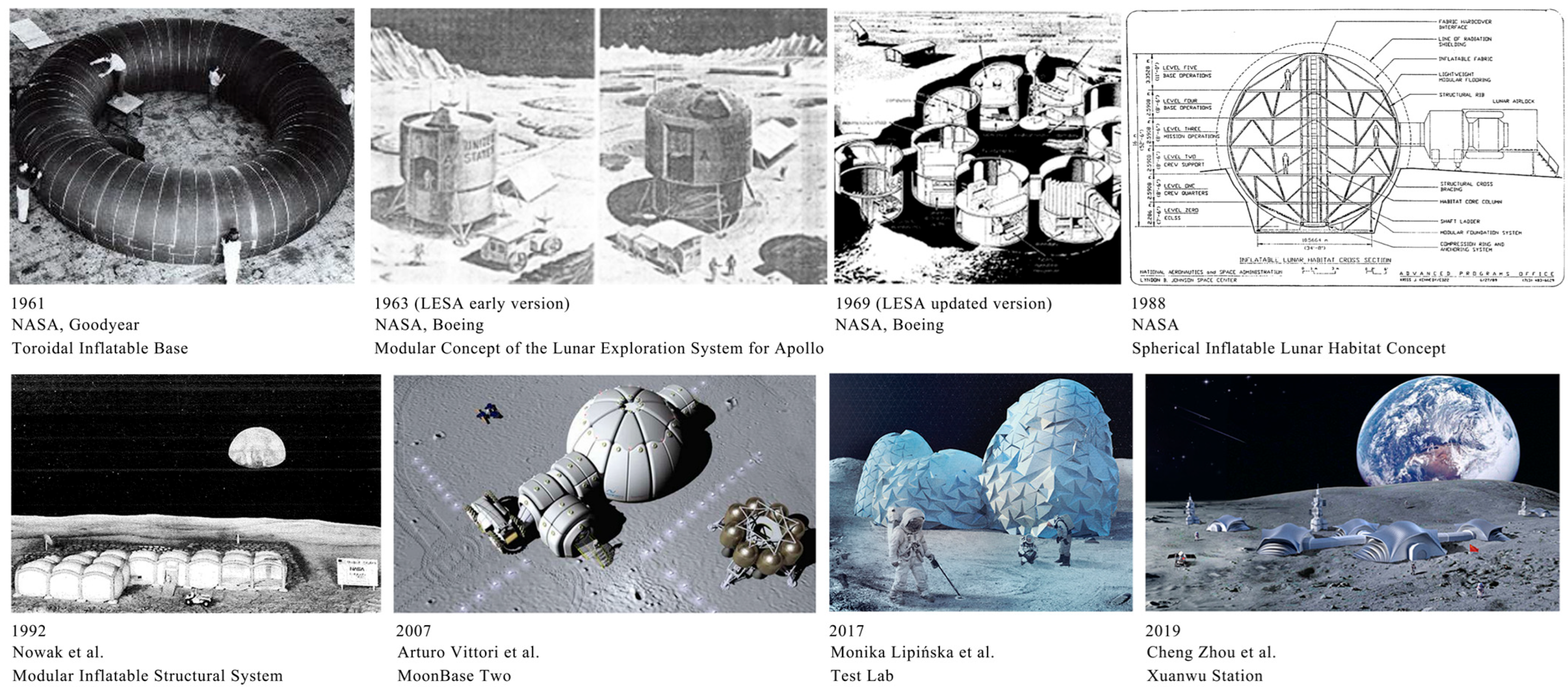
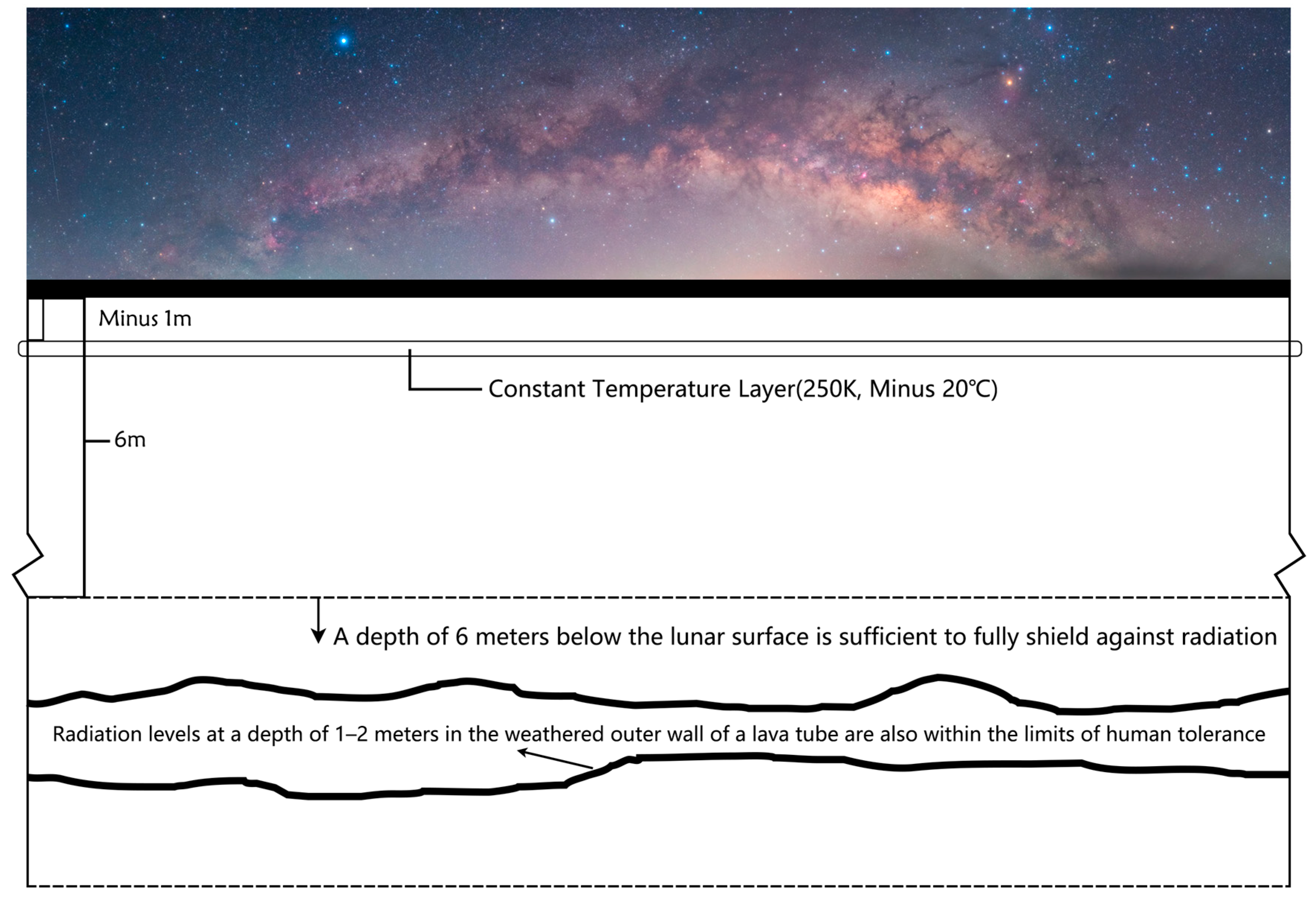

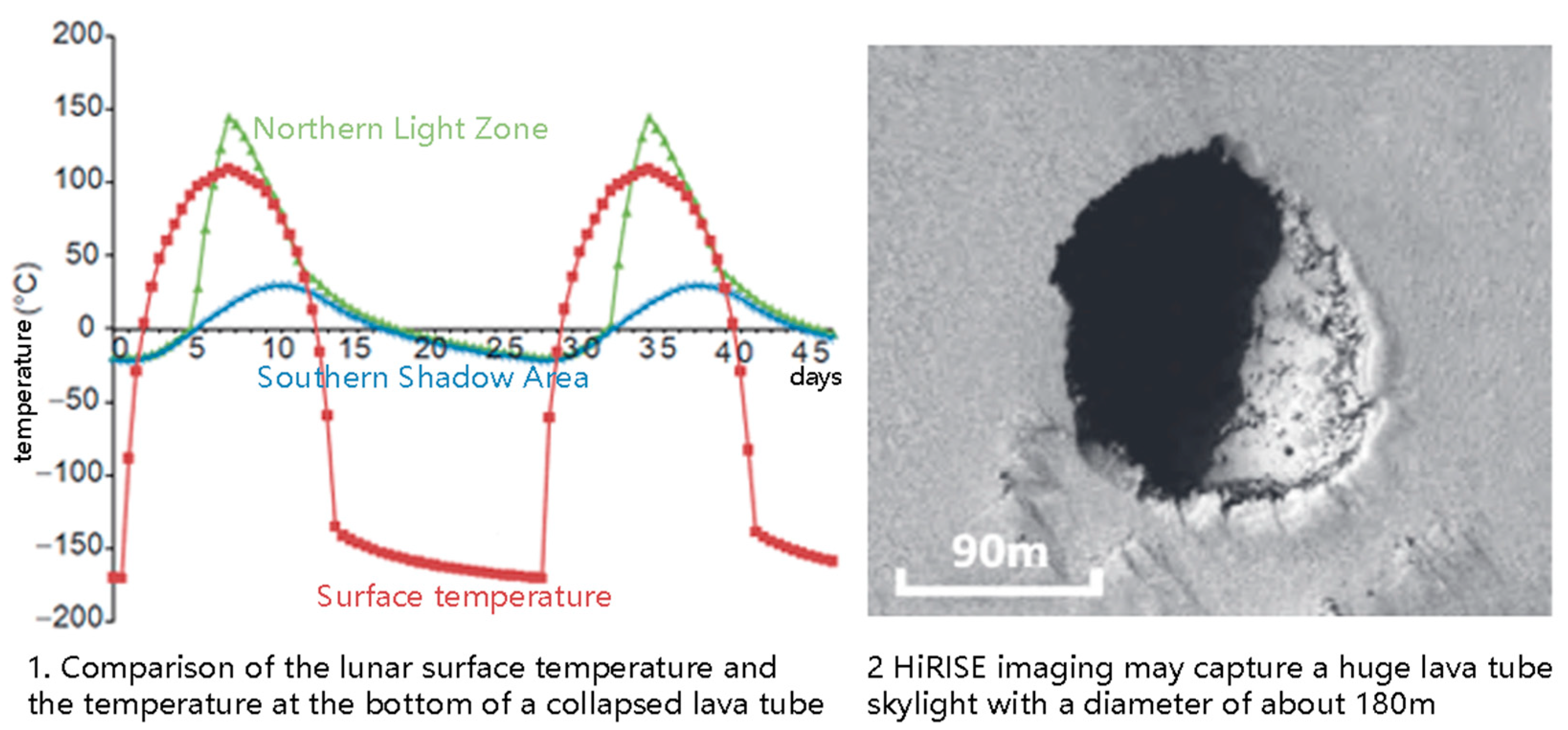

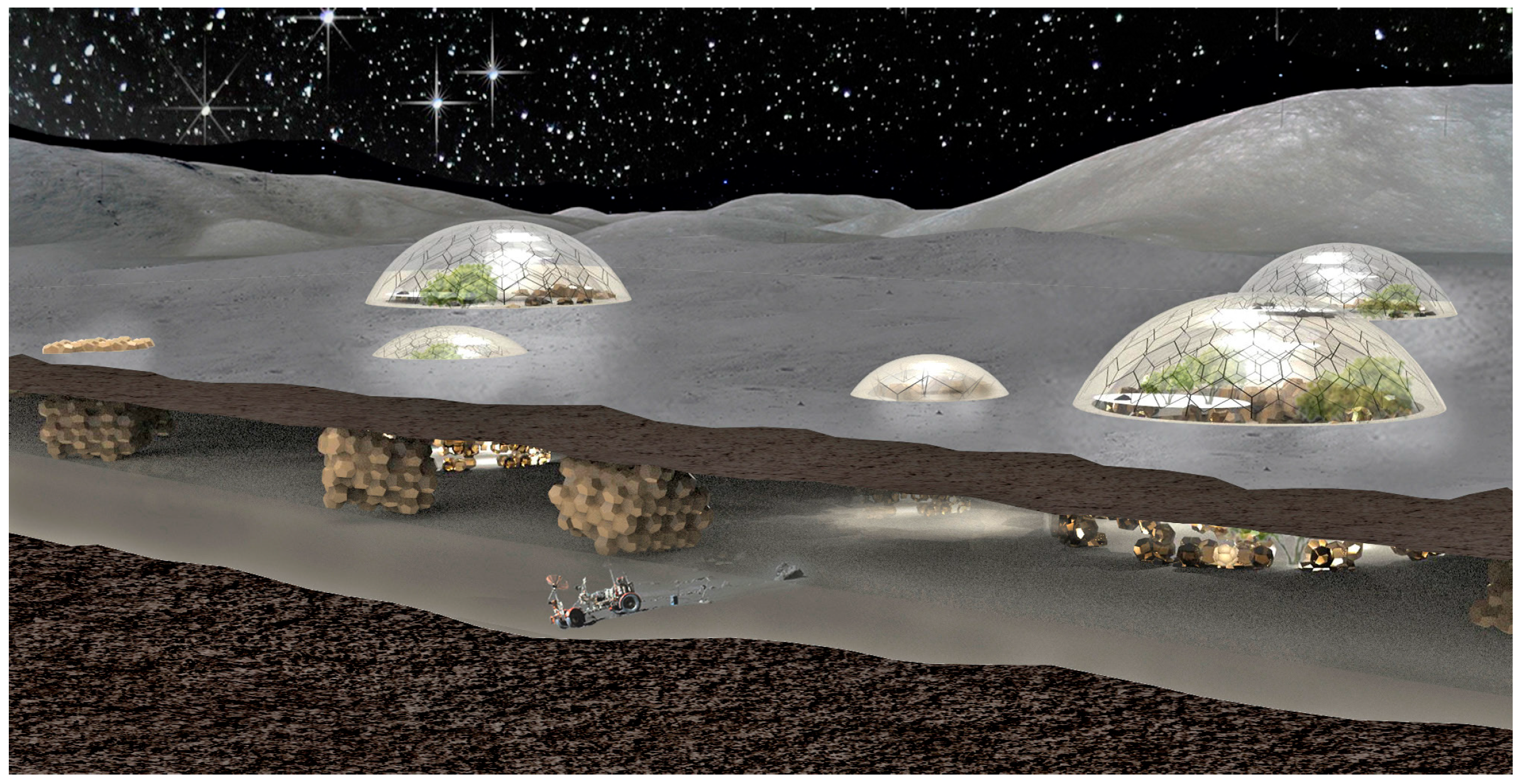






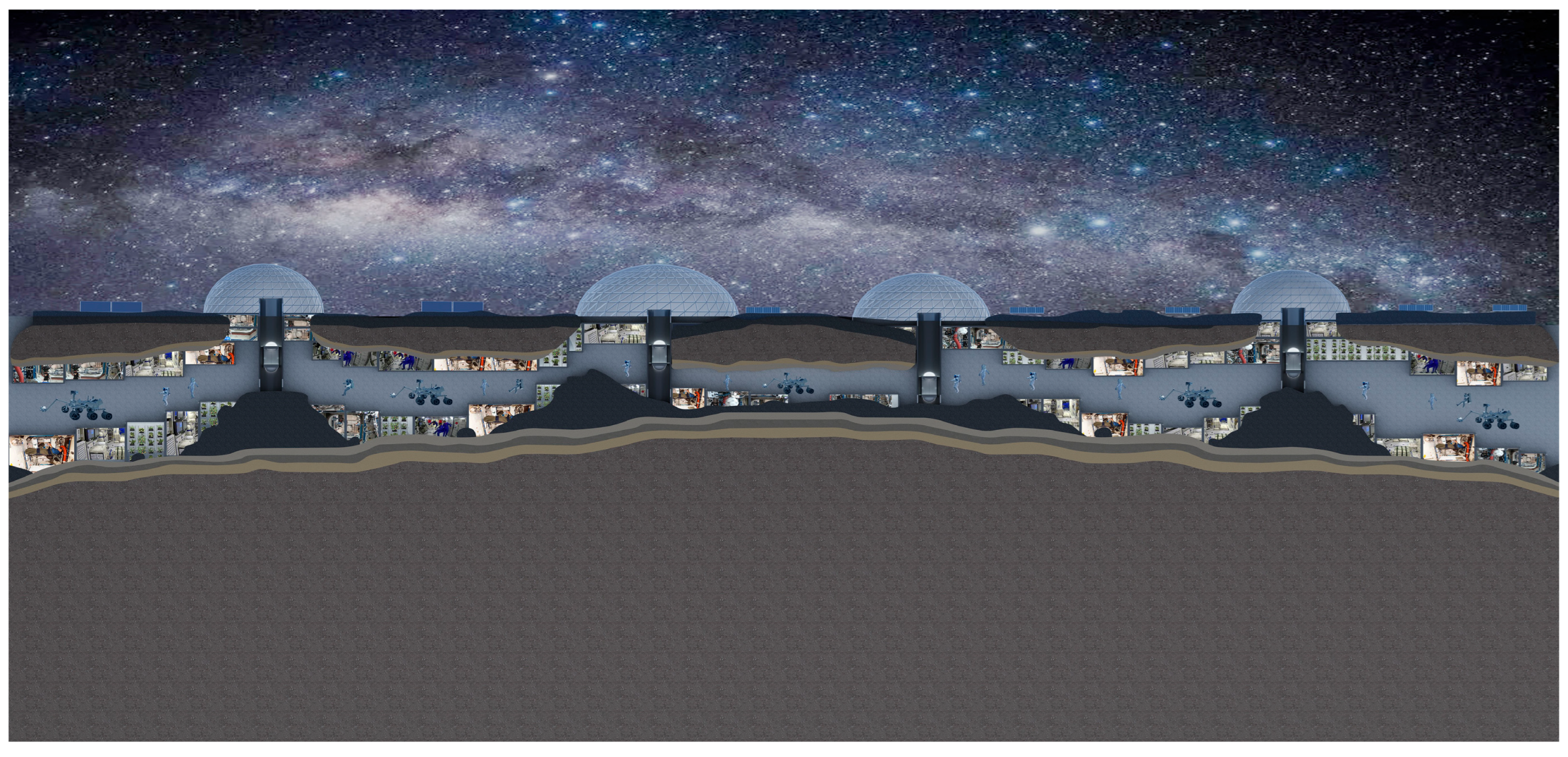

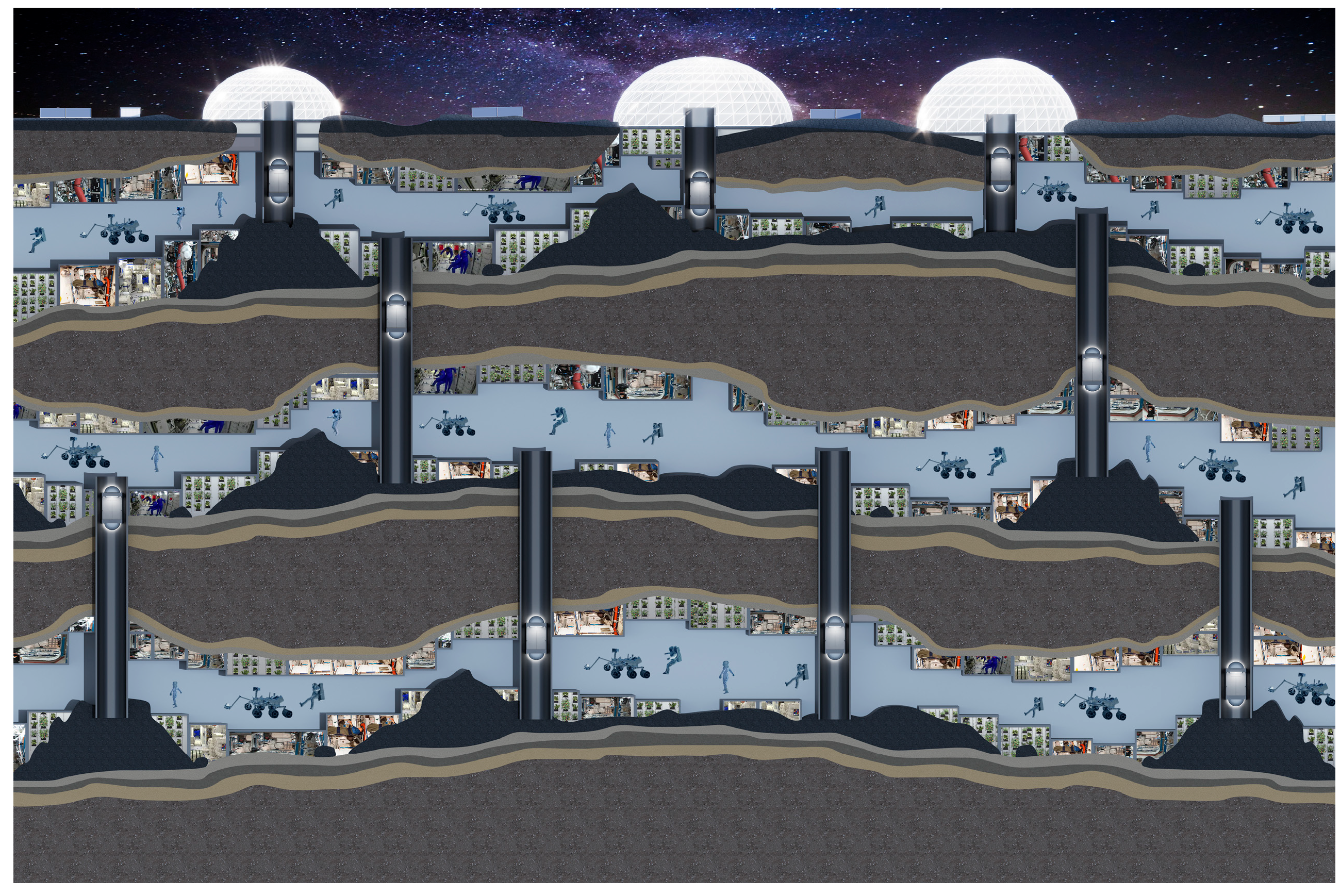
| Types of Extreme Environments to be Addressed | Some Representative Examples of Underground Architecture | Proposal/Construction Time | Main Functions |
|---|---|---|---|
| Severe cold | Underground “Shadow City” in Helsinki, Finland | 1960 | Avoiding the cold, continuing urban functions, and transportation |
| Montreal Underground City (RESO) | 1962 | ||
| PATH underground pedestrian system in Toronto, Canada | late 1960s | ||
| Sapporo underground shopping mall (pole town, aurora town), Japan | 1971 | ||
| Extremely hot | Iran’s “Shavadun” underground space | Dating back to at least ad 800 | Access to groundwater, cooling, ventilation, climate regulation |
| Derinkuyu Underground City in Cappadocia, Türkiye | 8th century BC to 1950s | Shelter from extreme weather, shelter from invaders, constant temperature | |
| Tunisian Berber troglodyte architecture | Caves in the area appeared between the 14th and 15th centuries, but settlements may have existed as early as the 11th century | Protect from the scorching sun and prevent sandstorms | |
| Coober Pedy Underground City, Australia | 1915 | Avoid hot and dry weather | |
| War/Defense | China Harbin “7381” giant underground project | 1973 | Civil air defense projects, integration of peacetime and wartime |
| Beijing underground city, China | 1980 | ||
| Swiss underground shelters and air-raid shelters | 1963 | Providing cover for people during war |
| Characteristics | Earth Surface | Lunar Surface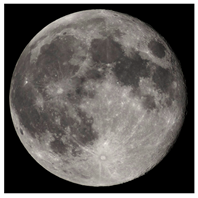 | Lunar Subsurface | |
| Environment | Temperature Range (°C) | −89~58 | −233~123 | −20~30 |
| Gravitational Acceleration (m/s2) | g | 1/6 g | 1/6 g | |
| Day-Night Cycle (d) | 1 | 29.5 | 29.5 | |
| Resources | Wide Variety | Lunar regolith covers the lunar surface | More than 100 types of minerals are found beneath the lunar surface (including mare basalts and cryptomare rocks not found on Earth), as well as water ice (in the polar craters of the Moon). | |
| Potential Energy Sources | Solar Energy, Wind Energy, Tidal Energy, Geothermal Energy | Solar Energy(Continuous and abundant) | Helium-3 (extremely abundant in lunar regolith), Geothermal Energy | |
| Available Space | Aboveground, Surface, and Underground Three-Dimensional Space | Unsuitable for utilization | Lava tubes have a vast volume | |
| Operational Safety | Protection from the atmosphere | Meteorite impacts, intense radiation, moonquakes | Relatively safer compared to the lunar surface | |
| Resources | Category | Utilization Method |
|---|---|---|
| Spatial Resources | Lunar Crater | Enclose with suspended structures or large-span membrane structures, then pressurize and inflate to create an “outdoor space.” |
| Lava Tube | Combine different morphological forms (enclosed, side openings, skylights, etc.) for future lunar base construction. | |
| Material Re-sources | Lunar Basalt | Preferred construction material, such as concrete made from lunar regolith (with an ultimate compressive strength and tensile strength approximately 10 times that of conventional concrete). |
| Lunar Regolith | Ceramic materials can be formed by microwave heating and sintering, and glass materials can be produced under vacuum conditions. | |
| Water Ice | Water ice resources exist in the permanently shadowed regions of polar craters, and water can be produced by hydrogen reduction of lunar regolith. |
| Spatial Adaptability | Environmental Adaptability | Climatic Adaptability |
|---|---|---|
| A. Spatial Utilization | D. Adaptive Building Materials | G. Passive Energy Saving of the Building Body |
| B. Modular Facilities | E. Use of High-Efficiency Insulating Lunar Regolith | H. Diverse Ecological Landscapes |
| C. Structurally Stable and Reliable | F. Establishing a Circular Ecosystem | I. Utilization of Renewable Energy |
Disclaimer/Publisher’s Note: The statements, opinions and data contained in all publications are solely those of the individual author(s) and contributor(s) and not of MDPI and/or the editor(s). MDPI and/or the editor(s) disclaim responsibility for any injury to people or property resulting from any ideas, methods, instructions or products referred to in the content. |
© 2025 by the authors. Licensee MDPI, Basel, Switzerland. This article is an open access article distributed under the terms and conditions of the Creative Commons Attribution (CC BY) license (https://creativecommons.org/licenses/by/4.0/).
Share and Cite
Xu, X.; Xue, M. Concept for the Future Utilization of Lunar Underground Space and Adaptive Design Strategies. Buildings 2025, 15, 4057. https://doi.org/10.3390/buildings15224057
Xu X, Xue M. Concept for the Future Utilization of Lunar Underground Space and Adaptive Design Strategies. Buildings. 2025; 15(22):4057. https://doi.org/10.3390/buildings15224057
Chicago/Turabian StyleXu, Xing, and Minghui Xue. 2025. "Concept for the Future Utilization of Lunar Underground Space and Adaptive Design Strategies" Buildings 15, no. 22: 4057. https://doi.org/10.3390/buildings15224057
APA StyleXu, X., & Xue, M. (2025). Concept for the Future Utilization of Lunar Underground Space and Adaptive Design Strategies. Buildings, 15(22), 4057. https://doi.org/10.3390/buildings15224057







